 |  |
| As is dealt with in depth in the previous sections of this book, it is evident that it is not possible to say that even a single cell came into existence by coincidence. Let's consider the following then: since even a single cell could not have come into existence by chance, is it possible to say that a variety of living beings came into existence by coincidence? The answer is certainly "No." Have you ever thought about the variety of living beings surrounding you? Let's think about all the plants we see in books, or in documentary series on television, all the carnations, roses, daisies, water lilies, giant tropical plants, pineapples, acacia trees. Let's remember their individual leaf structures, tastes, colours, scents, the methods of photosynthesis they employ, and all other details pertaining to them. |
Let's also consider animals; let's think about giraffes, antelopes, elephants, chickens, all types of fish, sparrows, peacocks, ostriches, rabbits, butterflies, and various insects. Let's think about their mechanisms, their habitats, and the way they hunt or reproduce.
Even such brief reflection would make us realise the variety of living beings on the earth on which we live.
There are 200 thousand butterfly species on earth. Furthermore, naturalists have found that these species embody 1 million types of butterflies, all having highly complex and remarkable individual systems which employ amazing camouflage techniques. Some, for instance, imitate a leaf to protect themselves from their enemies. Others, on the other hand, have eye-shaped patterns on their wings for the same purpose.
Consider the variety of these remarkable designs, and never PLEAD IGNORANCE of the fact that millions of living-beings, each so unique in their design, could not have evolved from each other.
A person who makes a conscious effort to understand
the miraculous attributes of living beings would easily find the answer to the question "how did these beings emerge?" Allah furnishes all living beings with extraordinary features and shows men the evident signs of His existence and might.
Never Plead Ignorance of this obvious fact that is so easy to see.
 |
He is the Originator of the heavens and the earth. How could He have a son when He has no wife? He created all things and He has knowledge of all things. That is Allah, your Lord! There is no god but Him, the Creator of everything. So worship Him. He is responsible for everything. (Surat al-An'am: 101-102)
Apart from this variety, a number of living beings in nature are equipped with astonishing systems and complex mechanisms by which they perform complicated tasks. These are actually tasks that are not even accomplished by human beings. The extraordinary designs that prevail in these mechanisms can by no means be explained by chance, as the theory of evolution suggests. Each living being is designed specially thus enabling it to survive in its particular habitat. It is unlikely that living beings could design these systems themselves. These flawless systems are inherent in their creation.
 |
| The extraordinary design discernible in the wing of a fly, flapping its wings 500 times a second. |
In this section, we will review only a few of these miraculous mechanisms observed in plants and animals.
While reading these examples, ponder deeply, and never PLEAD IGNORANCE of the fact that these mechanisms are so perfect that they could not have come into existence by themselves.
When we say "the flawless structures of animals", some people may think that we are talking about the interesting attributes of as yet unheard, uncommon living beings. However, everyone is familiar with the attributes we are talking about. There is great design in the body of an insect or a tiny bird. This design is so complex that, so far, no human being has ever accomplished the production of such a design. An attentive eye would have no difficulty in recognising that this design, which is obvious in all nature, provides solid evidence of creation.
For instance, it takes an enormous amount of energy for a fly to fly. That is why the fly has an entirely different respiratory system. Special, fine air tubes in their bodies directly transmit oxygen in the air to the cells, enabling the rapid combustion of oxygen. This, however, is only one of the miraculous attributes of a fly. Allah draws our attention to the superior design evident in the creation of fly:
Mankind! an example has been made, so listen to it carefully. Those whom you call upon besides Allah are not even able to create a single fly, even if they were to join together to do it. And if a fly steals something from them, they cannot get it back. How feeble are both the seeker and the sought! (Surat al-Hajj: 73)
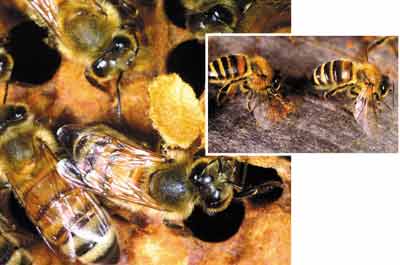 |
| Bees working to keep the heat of the hive at a constant temperature. |
Let's consider bees. Everyone is familiar with the social nature of bees or the hexagonal structure of honeycomb. However, the attributes of bees are not limited to these alone. Care for the hive is an essential part of the bee's life. Worker bees control the temperature, and manage the security and cleaning of the hive. Whatever the temperature outside, honeybees keep the temperature of the of the hive – especially the brood chamber – constant. In the chill of early morning, workers cluster over the comb, incubating the brood with body heat. As the day warms, the tightly knit cluster gradually disperses. If the temperature continues to climb, some of the workers begin to fan their wings, directing a cooling flow of air through the hive entrance and over the combs. On an extremely hot day, the bees must resort to an even more drastic cooling measure: They place drops of dilute honey at the openings of empty cells, evaporating the liquid in the airstream created by their wings. This cooling system reduces the hive temperature dramatically. If, however, there is still not enough fresh, unconcentrated honey on hand, the foragers begin to scout for water.4
Flawless conscious design is inherent in the living beings surrounding us. The attributes mentioned here are no doubt only a small part of their extraordinary features. These are evident signs for people of understanding of Allah's existence and of His might.
Nevertheless, some people never think about these or they ignore the miraculous attributes of living beings. Yet, NEVER PLEAD IGNORANCE about the superior creation and the unique art of Allah.
 |  |
| Fireflies, excelling modern technology, with their inherent systems. | |
The superiority and uniqueness of the creation of Allah are also displayed in living beings that we do not observe. A striking example is the Siberian salamander. These living beings can remain in the depths of frozen soil for years and return to their ordinary way of living when weather conditions improve and the ice melts. These salamanders can survive even at -50o C, thanks to an anti-freeze-like material produced in their bodies protecting them against freezing cold. This anti-freeze materiel replaces water in blood cells, preventing the tissues from damage caused by ice-crystals.5
There is an important feature of the light emitted by fireflies: this light has no heat, a condition called "cold light." In today's world, this would be considered a major technological breakthrough and is largely thought unattainable. An ordinary bulb transforms only 3-4% of its electrical energy into light. The remainder is transformed into heat. Fireflies, however, transform 100% of its energy into light, without the dissipation of any in the form of heat.6
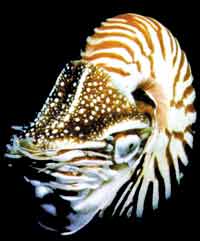 |
| Nautilus, an interesting marine animal. |
Diving tanks in a submarine filled with water make the submarine heavier than water, enabling it to sink to the bottom of the ocean. If water in the tank is emptied by pressurised air, the submarine floats again. Nautilus, a marine animal, also employs exactly the same method. A spiral organ shaped like a snail shell, and 19 cm in diameter, Nautilus embodies 28 interconnected "diving cells". How does Nautilus, then, find the pressurised air necessary to expel the water? Hard to believe, but Nautilus, through biochemical means, produces a special gas, which is conveyed to the cells through its bloodstream. This gas eventually expels the water in the cells. Nautilus pumps out the amount of water necessary to sink or float and hence performs essential functions like hunting or protecting itself against its enemies. A submarine dives to 400 metres while a Nautilus can dive to 4,000 metres.7
It is actually not man who invented cooling systems. Every warm-blooded living being possesses various mechanisms for temperature control. The gazelle, a fast running African animal, must often sprint to protect itself against its enemies. Such effort raises the body temperature. However, to survive, it is essential that the gazelle should keep its brain cool.
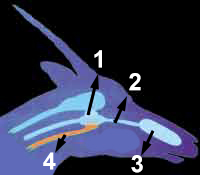 |  |
| 1. cooled arterial blood 2. cooled venous blood | 3. evaporation 4. warm arterial blood |
| (Left) The shematic picture of the skeletal structure of gazelle. | (Right) A gazelle prepared to escape its enemy. |
For this purpose, the gazelle has its own cooling system built right into its head. Gazelles have hundreds of small arteries that divide and pass through a large pool of blood lying next to its breathing passages. Air taken in by the animal cools this nasal pool, so the blood passing through the tiny arteries in it is cooled, too. Then, the tiny arteries come together in a single blood vessel that carries blood to the brain. In the absence of such a system, the gazelle simply could not survive.8
Hunting birds have keen eyes that enable them to locate their prey and protect themselves against them. Yet in this sense, no hunting bird is better equipped than the owl. Some species turn their heads through one hundred degrees, an ability very useful for extending the angle of vision of the owl's eyes.
No doubt, the most remarkable feature of the owl's eyes is their size. These big eyes cover a considerable part of the face and are separated only by a thin bone. The eyes rest tightly in the eye cavity and leave almost no room for muscles. They are unable to move and force the owl to use its flexible neck and turn in different directions.9
 |
Once the owl locates its prey's position, it should lose no time in attacking it. However, the majority of birds make noise while flying. The noise of the wings of an eagle, for instance, can be heard miles away, as can the wings of many other big birds. Noisy wings are obviously disadvantageous for a night hunter. However, the owl's soft feathers with their tassel-like structures at the ends allow the owl to fly noiselessly. The surface of the wings' velvet-soft feathers efficiently absorbs noise.10
Rattlesnakes are able to locate warm-blooded animals – a rat, for instance – even in pitch darkness. The rattlesnake can still sense a rat only 15cm away, although the rat causes a minor temperature change of only 0.005°C. Information regarding the prey is conveyed to the brain, assessed and responded to by the snake in less than 1/20th of a second. When we consider that one second is just as long as the blink of an eye, the incredible speed of the snake is better understood. The rattlesnake, finding the location of its prey without error, attacks and kills it with its poisonous teeth.11
 | 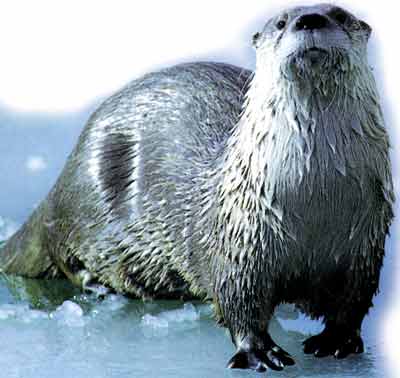 |
| Rattlesnakes, with their eyes sensitive to heat, can see warm-blooded animals even in pitch darkness. | A sea otter, protecting itself against the freezing cold of the Pacific by a special method. |
Sea otters comb their fur with their feet, a method they employ to clean and groom their fur with the oil made in their skin. This operation is a unique way of airing the fur since it enables tiny bubbles of air to be trapped by the thick underfur. In the freezing cold of the Pacific, the air bubble-holding capacity of the fur has an essential role in the perfect adaptation the sea otter has to unfavourable weather conditions. These bubbles simply protect sea otters against freezing. Matting of the sea otter's hair – usually caused by fuel waste products – simply means death.12
The Wedel seal can survive in the freezing waters of the Antarctic, even when the temperature drops below –26°C. It is not affected by intense and sudden changes of pressure when it dives to the bottom of the ocean, since before a deep dive, the seal makes several short dives. Opening and closing its rib bones and diaphragm, it lets out the air in its lungs and closes its lungs. After a while, when no air is left in the lungs, nitrogen does not dissolve and loses all possibility of entering the bloodstream. This is a process that enables the animal to survive. Contrary to the majority of mammals, seals have a flat oval-shaped trachea, rather than a round one, which easily closes under high pressure. Such a structure grants the seal perfect adaptation to its environment.13
 |
| A Hummingbird. |
During the day, the heart of a hummingbird beats between 500 and 1,200 times a minute. In the evening, its heartbeat slows down so much that its throb is virtually undetectable. Nor does the bird appear to be breathing. In effect, it is doing what a hedgehog does when winter approaches. It is hibernating. The hummingbird, however, has to hibernate 365 times every year.14
These are only a few examples of the divergence of living beings. However, these examples are enough to reveal the design inherent in them. It is unlikely that these elaborate systems could have occurred by chance. Coincidences have no consciousness; they can devise no plans. All these living beings are surely the product of conscious design. This flawless design is only one of the signs showing that all living beings are created. Allah, the Sustainer of all the worlds, granted these attributes to them. A subtle art and wisdom are displayed in His creation.
So, NEVER PLEAD IGNORANCE of the fact that these miraculous systems are only products of the superior creation of Allah.
Take a plant and look at its leaves closely. Examine the arrangement of its leaves, and its colour and brightness. Just consider how leaves of the top branches of trees hundreds of metres above sea-level remain green all year round? Then, turn and look at birds flying in the sky. Take a feather and analyse it under a microscope. Such an analysis reveals that birds' feathers are made up of thousands of tiny tendrils attached to one another by hooks.
 | 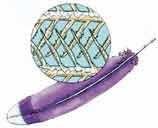 |
| Even the unique design of the feather is an indication of creation. | |
Analysis of various other living beings makes us arrive at the same conclusion: a detailed design is evident in all living beings. How did these feathers come into existence? Is it possible that these complex designs can be attributed to blind chance and coincidences?
Let's provide the answers to these questions by asking other questions. Is it possible for a plane to be constructed without conscious intervention? Alternatively, does a random arrangement of tiles make up a factory? The answer is obvious. Technological products supported by highly complex structures are designed and produced by intelligent men. Similarly, the flawless design observable in nature is the end product of an exalted Creator. This is an OBVIOUS fact.
Pierre Grasse, a prominent French zoologist and the former president of the French Sciences Academy states the following:
A single plant, a single animal would require thousands and thousands of lucky, appropriate events. Thus, miracles would become the rule: events with an infinitessimal probability could not fail to occur. There is no law against daydreaming, but science must not indulge in it.15
The thought that living organisms could come into existence by chance is only a figment of the imagination.
LIVING BEINGS DID NOT COME INTO EXISTENCE BY CHANCE. Allah, the Sustainer of the worlds, creates all of them. So, NEVER PLEAD IGNORANCE of this obvious fact, which today must be comprehensible to everybody.
 | 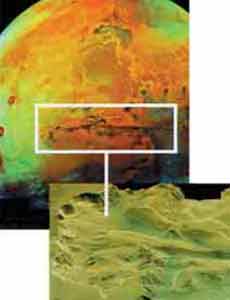 |
| The only planet supporting life in the solar system is the Earth. A section from the planet Mars (above). A comparison between other planets and the earth would make man feel the astonishing design inherent in this planet. | |
The wisdom, design and order we observe in nature prevail throughout the universe. From the world we live in to all the heavenly bodies in space, there is a flawless planning.
Our world is perfectly orderly. Countless billions of systems function simultaneously yet in total harmony. There is an incredible equilibrium within this gigantic network of systems, which reveals that life on earth, which rests on a delicate system of balances, is specially designed. A comparison between other planets in the solar system and the earth would show this fact better. The earth is the only planet in the solar system which supports life.
The delicate balances inherent in the planet make this possible. The velocity of the earth's rotation about its axis is one of them. These delicate balances make the earth a habitable place. For instance, the atmosphere of the earth consists of gases in ideal proportions for the survival of man as well as all other living beings (77% nitrogen, 21% oxygen and 1% carbon dioxide and other gases). Let's take one of these gases, oxygen, for instance. If the ratio of oxygen to the other gases were a little higher than 21%, the cells of living beings would be severely damaged. Moreover, the molecules of hydro-carbons and thus plants would also have no chance of existing.
If the proportion of oxygen to other gases were a little less, than breathing would be torture. Furthermore, the transformation of nutriments into energy would become impossible. Similarly, if the proportion of carbon dioxide in the air were greater, it would pose a threat to mankind since the atmosphere would keep more heat, increasing the overall temperature of the earth. A slight decrease in the amount of carbon dioxide, on the other hand, would cause great temperature differences between day and night, with the temperature falling below zero at nights. The proportion of nitrogen in the air is so delicate that oxygen, a flammable gas, acquires a vital importance for living beings.
The constant nature of atmospheric gases is another important factor for life. Plants produce around 200 billion tons of oxygen a year by transforming the carbon dioxide in the air into oxygen.
The mass of the earth, too, is ideal, and prevents the atmosphere drifting out into space.
 | |
| 1. Magnetic Field | 4. Outer Core |
| Life on earth exists on the "crust" of the earth, a section of 7 layers with a distance of 670 km. The crust, 6,370 km deep, makes up only 1% of the depth of this section. Scientists, drawing an analogy between an apple and the world, state that the outer part of an apple is similar to the crust of the earth whereon life exists, whereas the inner part of the apple is similar to the planet's interior, an inner core of molten elements. Just considering that 12km below the earth the temperature is about 60°C shows that the world is anything but serene and still. Possessions, children, career, and people's possessions, all belong to a life led on top of this core of molten elements. | |
With regard to these balances in the atmosphere, it is essential that the temperature of the surface of the earth should be relatively constant. This constancy is closely related to the regularity of the orbit that the earth follows around the sun, the size of the sun, the velocity of rotation of the earth and the inclination of the earth's axis.
There are various other balances that enable earth to support life.
The current power of the gravitational force exhibits a delicate balance. A slight increase in the gravitational force, would mean more ammonia and methane in the atmosphere, which would be detrimental to life. In the contrary situation, however, the atmosphere would fail to hold water, changing the world into an uninhabitable place.
The thickness of the earth's crust and the ozone layer, the water and nitrogen cycles on earth, the existence of mountains, the protective nature of the atmospheric layers are essential for the continuance of life.
Some people, however, lead lives having no idea of the delicate balances of the composition of gases in the atmosphere, the distance of the earth from the sun or the movements of the planets. The vital importance of such balances do not mean much to them. However, even a subtle change in one of these balances would become a major threat to the continuance of life. Furthermore, the above-mentioned are only a few among billions of delicate balances existing on earth. However, it is an OBVIOUS fact that even these are enough to show that they are all the products of a superior wisdom.
So, NEVER PLEAD IGNORANCE of the fact that such delicate balances could not have occurred by chance, and that only Allah the Almighty has the power to establish such an order.
4. The Marvels of Animal Behaviour, National Geographic Society, 1972, p. 59
5. New Scientist, Eugene Potapov, "How Salemenders Survive the Deep Freeze", Vol. 139, 11 September 1993, p. 15
6. Bilim ve Teknik (Science and Technology) Magazine, October 1987, No. 239, p. 10
7. Bilim ve Teknik (Science and Technology) Magazine, Vol. 20, No. 231, February 1987, p. 11
8. Lawrance O.Richards, It Couldn't Just Happen, p. 108
9. Gorsel Bilim ve Teknik Ansiklopedisi (Gorsel Encyclopaedia of Science and Technology), Vol. 3, p.782
10. Gorsel Bilim ve Teknik Ansiklopedisi (Gorsel Encyclopaedia of Science and Technology), Vol. 3, p.784
11. Gorsel Bilim ve Teknik Ansiklopedisi (Gorsel Encyclopaedia of Science and Technology), Vol. 7, p.2352
12. National Geography, June 1995, No. 6, Vol. 187, p. 50
13. Gorsel Bilim ve Teknik Ansiklopedisi (Gorsel Encyclopaedia of Science and Technology), Vol. 8, p.2660
14. David Attenborough, The Life of Birds, Princeton, New Jersey: Princeton University Press, 1998, p. 59